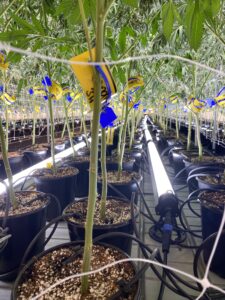
Menu
Menu

Companies are now incorporating far-red LEDs into their lighting fixtures, thanks to our research and that of other labs which have demonstrated the value of far-red light. In this seminar, I present “Far-Red: The Forgotten Photons.” These photons are just beyond our visible range but have a profound impact on plant growth, a fact we are only now discovering. Traditional electric lights lacked far-red light, so its importance remained hidden. However, with the advent of efficient far-red LEDs, we can now include these photons in artificial lighting.
Our research, fascinating from a fundamental photobiology perspective, also holds significant commercial implications. Far-red photons not only influence photosynthesis but also plant shape. These findings challenge traditional notions and offer exciting possibilities for manipulating plant growth.
Far-red light resides on the edge of human vision, and it’s a crucial focus of this seminar. I’d like to acknowledge my colleagues, Shuyang Zhen and Paul Kusuma, who have contributed significantly to this research.
Our work has been primarily funded by NASA and, more recently, the USDA through the LAMP project, which combines fundamental and applied research to explore the value of far-red photons.
Traditionally, we count only certain photons as photosynthetic, but our research suggests we need to revise this definition to include far-red photons, particularly in canopy photosynthesis, where they play a more substantial role than previously thought.
In plant research, we classify light into blue, green, and red categories. While blue and red light have well-known effects, green light is gaining recognition for its role in photosynthesis. Far-red light, however, is still relatively unexplored.
I’ll share a story from Shuyang’s study involving different light sources and lettuce growth. Surprisingly, chambers with magenta light (a mix of red and blue) grew equally or better than those with white light. The twist? The magenta chambers received additional far-red photons, challenging conventional wisdom.
To understand this, we delve into the mechanism. Photosynthesis involves photon energy exciting electrons, generating ATP and NADPH. Far-red photons can substitute for traditional ones, given the presence of visible light. This is governed by the Stark-Einstein Law: one photon excites one electron.
Our experiments across various plant species, including spinach, basil, kale, corn, sunflower, and wheat, consistently showed the value of far-red photons in photosynthesis.
Commercially, far-red photons offer exciting possibilities. When reframing data to focus on photon flux rather than energy, far-red photons match the effectiveness of red and blue ones. This opens new opportunities in agriculture and plant science.
Far-red photons also impact plant growth. They can induce shade-avoidance traits, making plants grow taller or broader, depending on the species. For instance, lettuce benefits from additional far-red light, but tomatoes and cucumbers respond differently.
In summary, our research reveals the untapped potential of far-red photons in plant growth. They challenge conventional definitions of photosynthesis and provide exciting commercial opportunities. Far-red light is not just a forgotten part of the spectrum; it’s a game-changer in plant science and agriculture. Thank you for joining us in exploring “Far-Red: The Forgotten Photons.”

Grow Pros Solutions is the NOW for Horticultural Science & Engineering. Grow Pros Solutions is one of the leading manufacturers of high-performance LED grow lights designed for cannabis cultivation. Our focus is to create top performing lighting solutions and fixtures that enable previously unobtainable and unthinkable results, increasing productivity from 30-60%. Our unwavering commitment to advancing technology and finding more efficient and sustainable solutions has made us a gamechanger for thousands of commercial and home growers.
Enter your email here to confirm your interest
All Rights Reserved by GrowPros Solutions